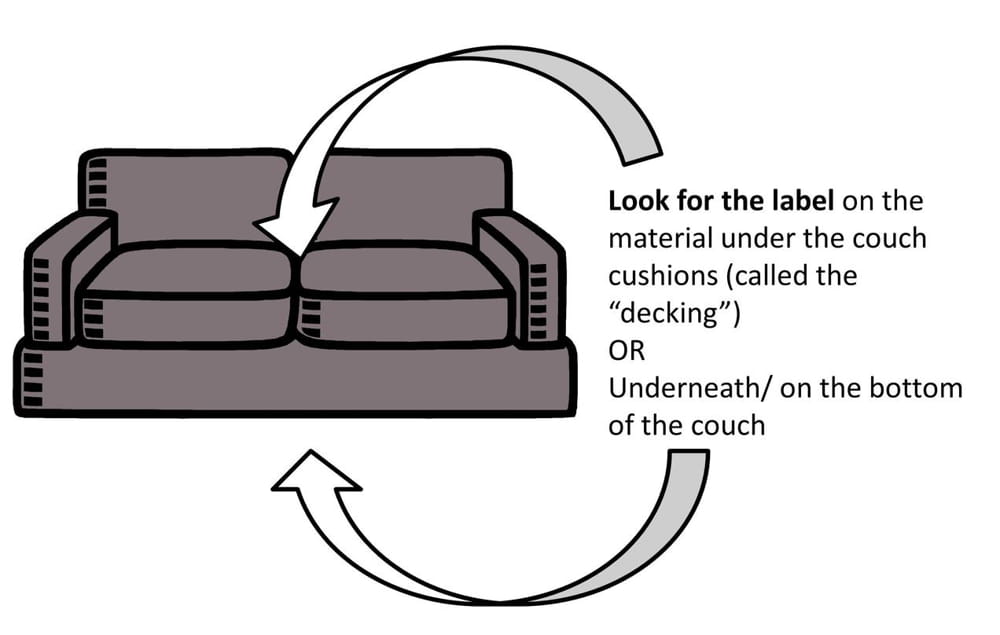
This section will provide a brief introduction to the topic of fire retardant sofas.
Many people are concerned about the safety of their home and this is especially true when it comes to their furniture. Some people are not aware that there are some sofas that have been fire retardant treated, which means that they have been treated with chemicals that make them less likely to ignite or burn in a fire.
Sofas can be made from a variety of materials and some of them are more likely to ignite or burn than others. It is important for consumers who want protection against fires in their home, to purchase a fire retardant sofa made from material such as cotton or wool which do not ignite easily.
How do I know if my couch has flame retardant?
Your couch should have a tag stating if flame retardants are present. If you have upholstered furniture manufactured before 2015 it is likely to contain flame retardants. However, you might be able to replace the foam with healthier flame retardant-free material and keep the furniture.[1]
Do all couches have flame retardants?
If you have a couch bought pre-2015, chances are it contains flame retardants. Even with these regulation changes, some couches still contain flame retardants today, so it is essential to verify if your couch is flame-retardant free.[2]
How do I know if my couch is toxic?
If there isn’t a label on the bottom of the couch or sofa, it’s safe to assume there ARE toxic flame retardants in the product. Ask the manufacturer if the couch has been treated with a stain resistant coating, or if flame retardants have been used to treat the fabric.[3]
Does most furniture have flame retardant?
Some good news is that most new furniture will now have a tag that instead says the furniture complies with an updated standard, TB117-2013, and include a check box specifying whether or not the furniture contains flame retardants. Most new US furniture does not have these chemicals.[4]
Is all upholstery fabric fire retardant?
The fabric has not been tested for its ability to withstand fire. Fabrics that are not rated can only be used for upholstery if they are first chemically treated with a fire retardant treatment. Chemical treatment consists of either soaking the fabric in a fire retardant chemical or back-coating it with fire retardant.[5]
Can my couch be making me sick?
In addition to the gross-out factor, your favorite overstuffed sofa or armchair actually could be making you sick if you are sensitive to the allergens or irritants it holds, allergists say. Indoor allergens produce symptoms similar to pollen allergy symptoms, such as coughing, sneezing and watery eyes.[6]
When did furniture become fire retardant?
The Furniture and Furnishings (Fire Safety) Regulations 1988 (as amended in 1989, 1993 and 2010) set levels of fire resistance for domestic upholstered furniture, furnishings and other products containing upholstery.[7]
Are leather sofas treated with flame retardant?
As said above, leather sofas tend not to contain flame retardants in the covers, and it’s in cover treatments that you find the most toxic variety – brominated flame retardants. Also, as we’ve seen, these wear off easily. The fillings in leather sofas almost always contain flame retardants.[8]
How do you test a couch?
1) Unzip seat cushions. Better-quality pieces have foam covered by batting enclosed in muslin. 2) Knead the frame along back, rail, corners and arms. If you feel hard or sharp edges, padding is skimpy. 3) The sofa back should be padded to give a finished look.[9]
How do you get rid of furniture VOCs?
One of the easiest methods to rid your new furniture of VOCs is with off-gassing. “Heat, air, and time are the best ways to bring down that initial off-gassing odor,” says building biologist Corinne Segura, of My Chemical-Free House. “Set the piece aside in an area that’s as warm as possible and has good airflow.[10]
Should I be worried about flame retardants?
Although flame retardants can offer benefits when they are added to some products, a growing body of evidence shows that many of these chemicals are associated with adverse health effects in animals and humans. These include: Endocrine and thyroid disruption. Impacts to the immune system.[11]
How do you know if fabric is flame resistant?
Polyester, wool, nylon, and silk are generally flame resistant due to the structure of the fabrics and the way they’re woven. They usually don’t need to be treated with special chemicals. Nylon, polyester, wool, and silk are all generally self-extinguish and difficult to ignite.[12]
